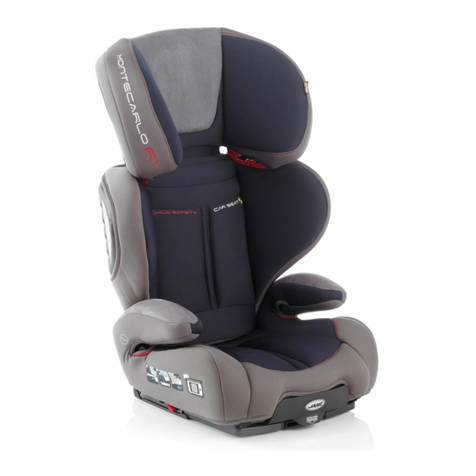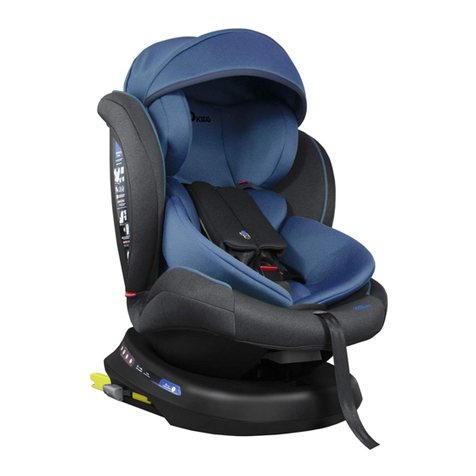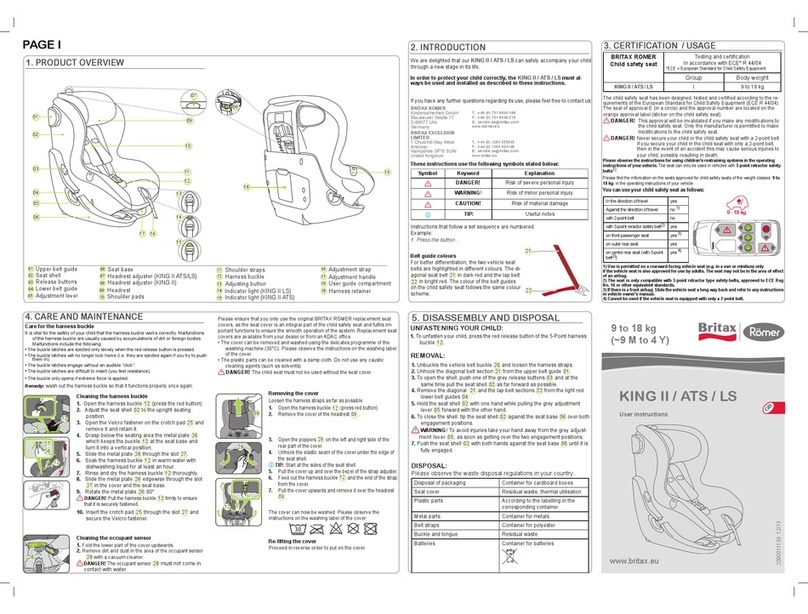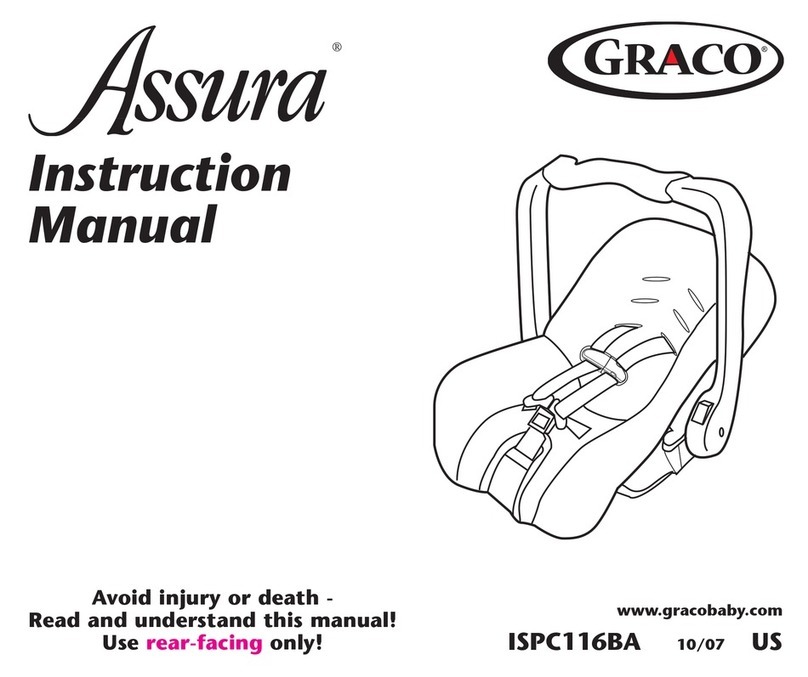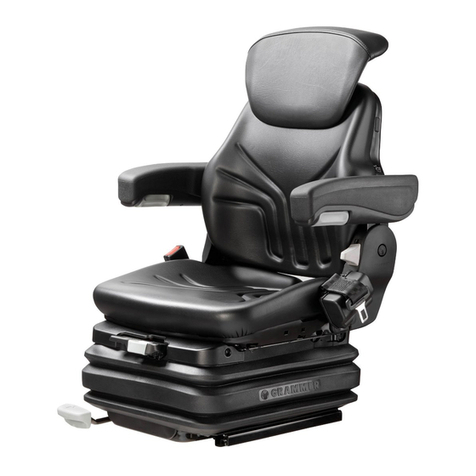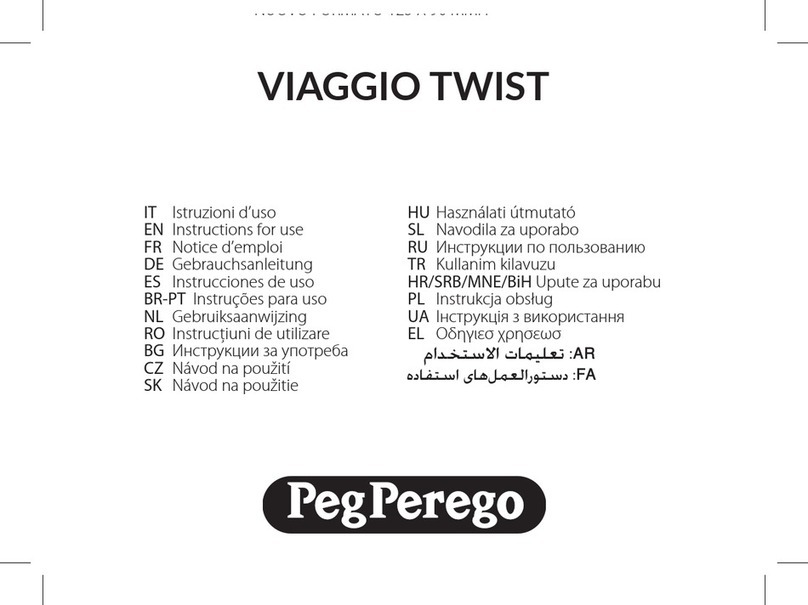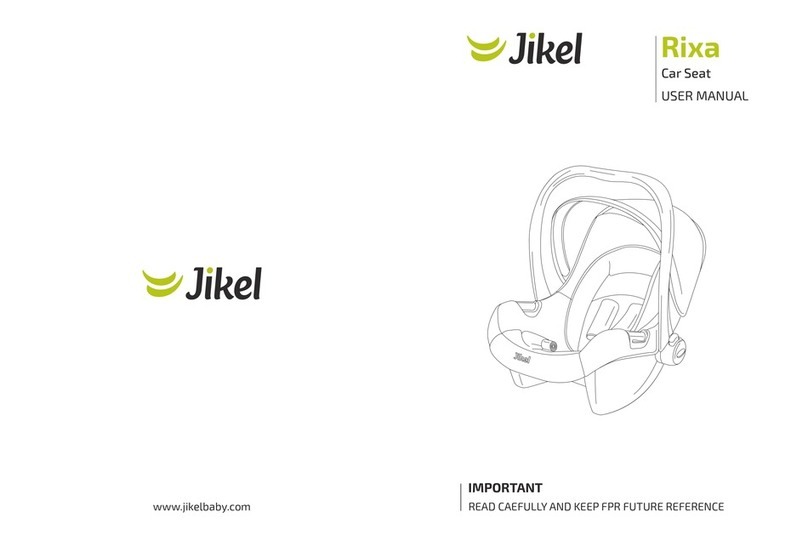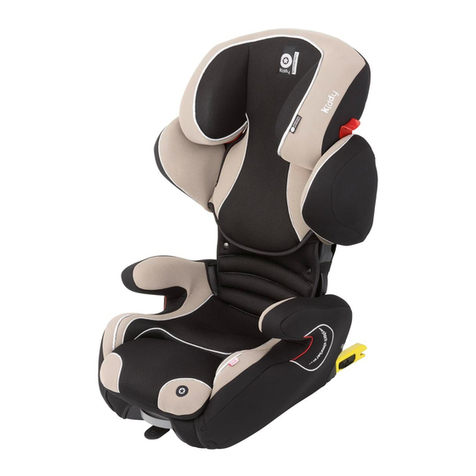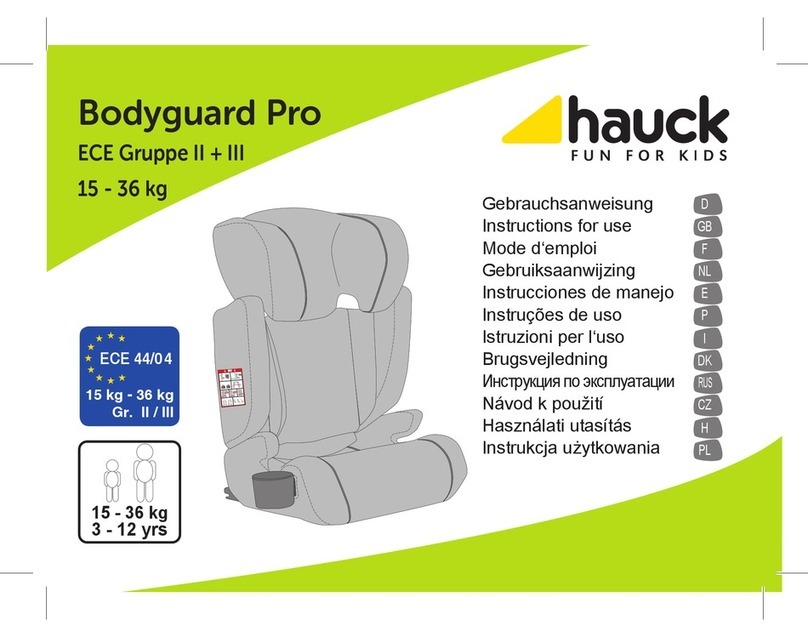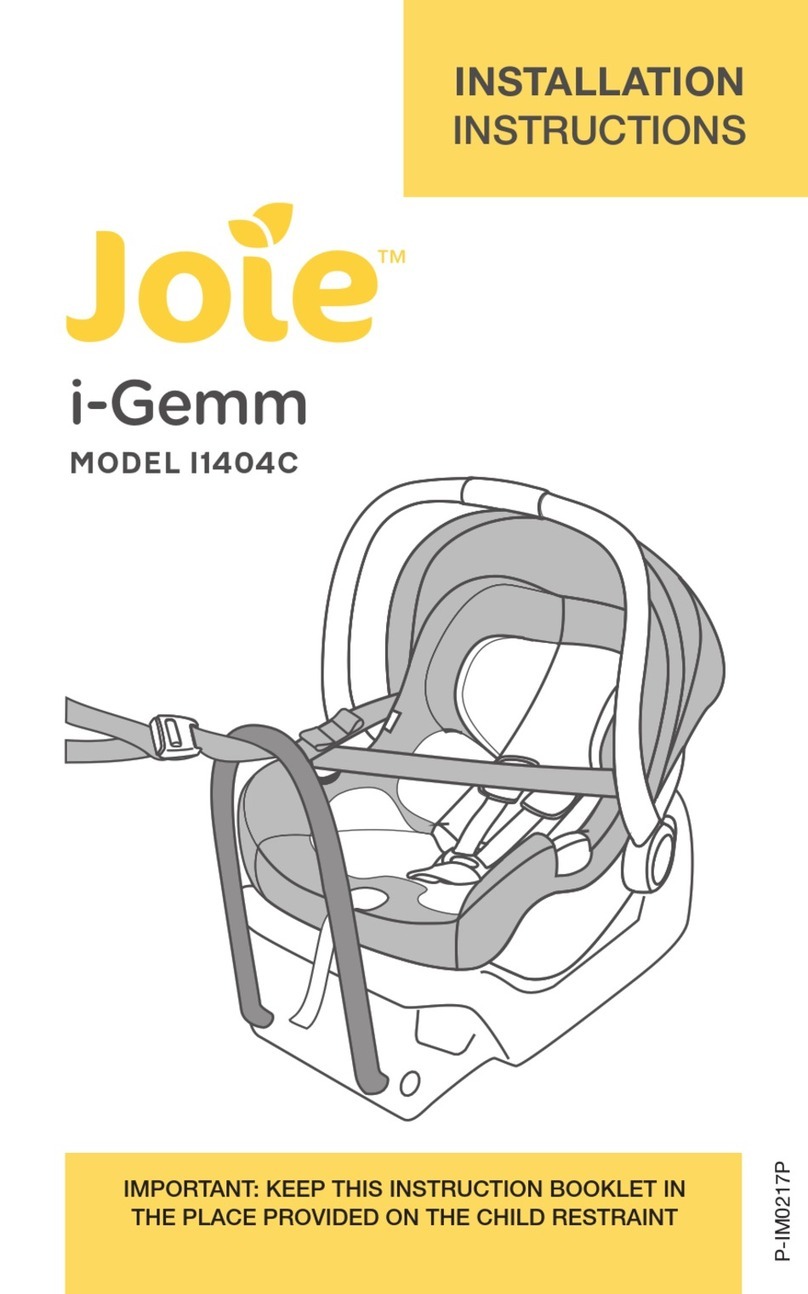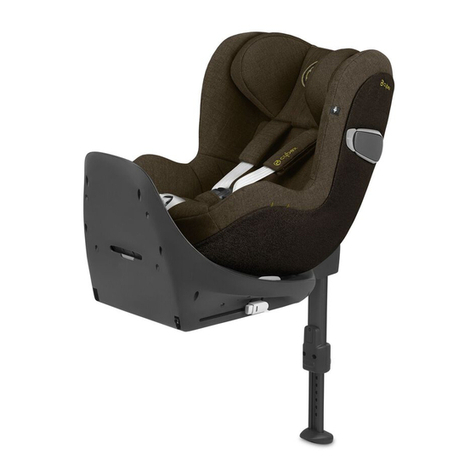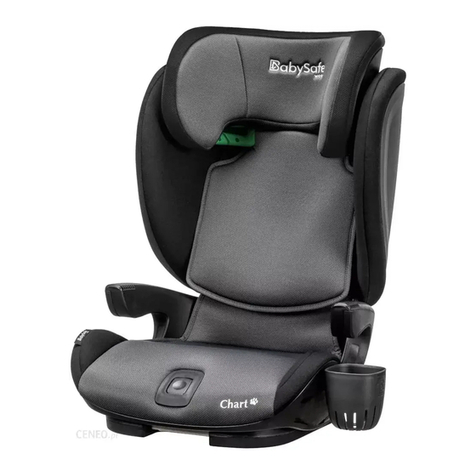My Child Chadwick User manual

Chadwick Car Seat
Group 0+,1,2,3 ISOFIX child car seat
This product conforms to ECE R44.04
Group 0+,1,2,3 child restraint. Suitable for children from birth to 36kg (approx 0 to 12 years
old)
Instructions: Please read carefully and keep for future reference. Your child’s safety may
be affected if you do not follow these instructions.
V3

2
1. Your 3 year warranty 3
2. General safety information - READ FIRST 3-6
3. Welcome 7
4. Parts checklist 8-9
5. Positioning the child restraint 9-10
6. Using the 5-point harness 10-11
7. Headrest/harness adjustment 11
8. Seat rotation 12
9. Seat recline 12
10. Installation Group 0+ [Birth-13kg] 13-19
a. Rearward-facing using ISOFIX and Top Tether 13-15
b. Rearward-facing using Vehicle’s 3-point Seat Belt 16-17
c. Rearward-facing using ISOFIX and Vehicle’s 3-point Seat Belt 17-19
11. Placing a child in the child restraint (Group 0+ [Birth-13kg]) 20-21
12. Installation Group I [9-18kg] 22-25
a. Rearward-facing using ISOFIX and Vehicle’s 3-point Seat Belt 22
b. Forward-facing using ISOFIX and Vehicle’s 3-point Seat Belt 22-24
c. Forward-facing ONLY using Vehicle’s 3-point Seat Belt 24-25
13. Placing a child in the child restraint (Group I [9-18kg]) 26-27
14. Removing the 5-point harness system for Group II, III mode 27-29
15. Installation Group II [15-25kg] and Group III [22-36kg] 30-31
a. Forward-facing using ISOFIX and Vehicle’s 3-point Seat Belt 30-31
b. Forward-facing using Vehicle’s 3-point Seat Belt 31
16. Placing a child in the child restraint (Group II-III [15-36kg]) 32
17. Removing the ISOFIX installed car seat 33
18. Removing and tting the seat covers 33-34
19. Retting the 5-point harness 34
20. Maintenance and cleaning 35
Contents

3
This child restraint system is approved to Regulation ECE-R44/04 under three
categories of installation.
1. Semi-universal ISOFIX CRS Group 0+ (birth-13kg). Install child car seat with ISOFIX
connector + Top Tether.
a) This child restraint is classied for “Semi-Universal”. It will t vehicles with
positions approved as ISOFIX (as detailed in the vehicle handbook), depending
on the category of the child seat and of the xture.
b) The mass group and the ISOFIX size class for which this device is intended is
Group 0+ (0-13kg) ISOFIX size class D.
2. Semi-universal CRS Group 0+, 1, 2, 3 (birth-36kg). Install child car seat with ISOFIX
connector + 3-point safety belt.
a) Only suitable if the approved vehicles are tted with 3-point safety belts,
approved to UN/ECE Regulation no. 16 or other equivalent standards.
3. Universal CRS, Group 0+, 1, 2, 3 (birth-36kg). Install child car seat using a vehicles
3-point safety belt.
a) This is a universal child restraint. It is approved to regulation No. 44, 04 series of
amendments, for general use in vehicles and it will t most, but not all, car seats.
b) A correct t is likely if the vehicle manufacturer has declared in the vehicle
handbook that the vehicle is capable of accepting a “universal” child restraint
for this age group.
c) This child restraint has been classied as “universal” under more stringent
conditions than those which applied to earlier designs which do not carry this
notice.
d) Only suitable if the approved vehicles are tted with 3 point safety belts,
approves to UN/ECE Regulation No. 16 or other equivalent standards.
4. If in doubt, consult either the child restraint manufacturer or the retailer.
Safety
NOTICES
Your 3 year warranty
Whilst we make and test our products to the highest standards of durability there’s
always a small chance of a hiccup! Our promise is to repair, replace or refund a
MyChild product that has an identied manufacturing defect from the date of
purchase for a full 3 years thereafter at no extra cost.
However, you must register within 28 days of the date of purchase to receive the full 3
years guarantee!
To receive your full guarantee you can register your product by:
visiting www.mychildonline.co.uk/warranty.html and complete the warranty form, or
by telephone on 0161 335 2508.

4
5. Child car seats can mark vehicle seat upholstery. The manufacturer cannot be
held responsible for damage or marking to vehicle seats.
6. The following situations could be illegal and will invalidate the warranty:
a) Any modications or change of use of the child car seat that have not been
authorised or advised by the manufacturer.
b) Any failure to t the child car seat in strict accordance with the instructions.
7. The manufacturer accepts no liability for issues arising from unauthorised
modications, uses or tting.
8. Please keep this manual safe for any possible queries you may have in the
future.
9. You will need to keep your proof of purchase. We recommend you keep them
together.
Getting started
Before starting
Warning: Do not t the child restraint on a side or rear facing vehicle seat.
Warning: Before installing the child restraint ensure that the passenger seat you are
using is locked in the upright position.
Warning: Do not use the child restraint in the home - it has only been designed to be
used in the car.
Warning: Do not leave loose/unsecured objects on the rear passenger seats of your
car or the parcel shelf. They may be dangerous to your child if you are forced to
brake suddenly.
Warning: NEVER leave your child unattended – your child’s safety is your responsibility.
Warning: The child restraint must be tted in accordance with the manufacturer’s
instructions. Incorrect installation could be dangerous.
Warning: This installation must only be performed by a competent adult. Don’t try to
install the child restraint when intoxicated or drowsy.
Warning: Always ensure that new or occasional users [e.g. grandparents] have read
the instructions or been taught the correct installation by someone who has read and
understood the instructions.
Warning: Always keep this instruction manual with the child restraint, or in the vehicle
in which you are carrying the child restraint. Some models of child restraint have a
pocket to store the instructions.
IMPORTANT:DO NOT USE FORWARD FACING BEFORE THE CHILD’S WEIGHT
EXCEEDS 9KG
Read Carefully Before Attempting to Fit the Child Car Seat
Safety

5
Airbags and your child’s safety
EXTREME HAZARD
NEVER USE IN FRONT PASSENGER SEATS EQUIPPED WITH AIRBAGS
(SRS)
THIS CAN INCLUDE REAR PASSENGER SEATS THAT ARE EQUIPPED
WITH AIRBAGS*
*Consult car manufacturer for suitability. Children’s bodies are not able
to withstand the forces exerted on them by a deploying air-bag
Warning: Make sure that the child restraint is placed somewhere so that rigid items and
plastic parts do not become trapped in doors or movable seat units when the seat is in
everyday use.
Warning: Always use the vehicle’s door child safety lock system, if one is available, to
make it impossible for the child to open the car doors from inside.
Warning: Allow the child a break during long car journeys and make sure they don’t get
out of the car unaided and without supervision.
Warning: The child restraint must be tted securely to the passenger seat. Ensure that it is
not loose or wobbly after you have tted it. If it is loose, re-t it.
Warning! Do not use any load bearing contact points other than those specied in
these instructions and marked on the child restraint.
Warning: The child restraint must not be used without its original cover. The original cover
is essential for the safe operation of the child restraint.
Warning: Stop the car at regular intervals to check that the child restraint is in the correct
position and that both the car seatbelt AND the child restraint harness are still taut and
latched.
Warning: In the event of an emergency it is important to be able to release the child
quickly (as dened by ECE Standards). This means that the seat buckle cannot be fully
tamper proof and you should actively discourage your child from playing with or using
the buckle.
Warning: If you travel with passengers using both the front and the rear passenger seats,
the lighter occupants should be in the rear and the heavier occupants in the front.
Warning: If you have no option other than to put your child restraint on a rear passenger
seat next to side airbags:
- Consult with your vehicle manufacturer for side airbag details. It may not be safe.
- Make sure your child does not lean into the area immediately around the airbag.
Warning: Do not place anything under the child restraint (e.g. a towel or cushion) as this
could affect the performance of the restraint in an accident.
Warning: Avoid winter clothing bundling - Bulky clothing can lead to incorrect harness
tightening. In an accident, the child can slip right out of the extra padding - and thus
out of the restraint. Let the car warm up or cool down prior to placing your child in there
if possible. If your child is cold, place a blanket over the top of the harness.
When using the child restraint

6
Warning: NEVER use any load bearing contact points other than those described in
these instructions or marked on the child restraint.
Warning: Ensure that the lap section of the harness is worn low down, so that the pelvis
is rmly engaged.
Warning: Make sure that ALL the passengers in your vehicle have their seatbelts
fastened, as unrestrained people can be very dangerous to the child in an accident.
Warning: NEVER use a seatbelt routing scheme that differs from these instructions.
Warning: The harness must be used at all times when your child is in the child restraint.
Warning: If you are installing the child restraint using a seatbelt ensure there are no
twists in the seatbelt.
Seatbelt
Back of the seat/headrest
Warning: Ensure that the child restraint is as close as possible to the backrest of the car
seat.
Warning: REMOVE the headrest of the passenger seat being used if it obstructs the
proper installation of the child restraint. REMEMBER to ret the headrest when the child
restraint has been removed.
Warning: Don’t leave your child in the child restraint while parked in direct sunlight or
on a hot day.
Warning: Do not subject the child restraint to prolonged direct sunlight as this may be
dangerous for your child (the metal and plastic ttings could become hot) and may
cause the fabric to fade. You can reduce this problem by covering the child restraint
with a sheet when not in use.
Sunlight/hot days
Warning: Never buy a second hand child restraint. It may have unseen damage.
Warning: The manufacturer only guarantees this product when the original owner uses
it.
Warning: You MUST replace the child restraint and your vehicle’s seatbelts if they
becomes badly worn or damaged.
Warning: You MUST replace the child restraint if it is involved in an accident – it may
have unseen damage and may not protect your child as well as it should. At the
very least send the child restraint to the manufacturer for inspection, together with an
accident report.
Second hand or damaged child restraint & seatbelts

7
Welcome
Thank you for purchasing the Chadwick Car Seat.
Please read these instructions carefully before use to ensure safe and satisfactory
operation of this product.
The Chadwick Car Seat is suitable for:
Your child’s safety is your responsibility. If you have a query with this product or
require replacement parts, please contact your nearest MyChild retailer.
http://mychild.co.uk/tting-lists.php
This car seat has been classied for both “Universal” and “Semi-Universal” tting.
For “Semi-universal” tting the car seat can only be used in vehicles that are tted
with a 3 point safety belt & standard ISOFIX connectors approved to ECE R16 or
other equivalent standards.
Seat positions in other cars may also be suitable to accept this child restraint.
Please refer to our vehicle tting list available online at our website:
* “Semi-Universal” installaion.
** “Universal” installation.
Group Weight Approx. Age Child Restraint Direction Fitting Methods
0+ Birth-13kg 0 to 14 mths Rearward-facing ONLY
1. ISOFIX + Top tether *
2. ISOFIX + 3-point seatbelt *
3. 3-point seatbelt **
I9-18kg 9mths to 4 yrs
Rearward-facing 1. ISOFIX + 3-point seatbelt *
Forward-facing 2. ISOFIX + 3-point seatbelt *
Forward-facing ONLY 3. 3-point seatbelt **
II 15-25kg 3 to 7 yrs Forward-facing ONLY 1. ISOFIX + 3-point seatbelt *
2. 3-point seatbelt **
III 22-36kg 6 to 12 yrs Forward-facing ONLY 1. ISOFIX + 3-point seatbelt *
2. 3-point seatbelt **

8
Parts checklist
A
I
J
K
Q
R
S
B
C
D
E
F
G
H
L
M
N
O
P

9
The child restraint can only be used with either an approved ISOFIX anchorage system
and/or an automatic 3-point safety belt (i).
It MUST NOT be used with a 2-point lap belt (ii).
If your centre rear passenger seat is tted with an approved ISOFIX anchorage system
and/or a 3-point safety belt (i) then you will be able to use it.
IMPORTANT: If your centre rear passenger seat is tted with ONLY an approved ISOFIX
anchorage system and IS NOT tted with a 3-point safety belt (i) then you will only be
able to use the centre rear passenger seat for installing the child restraint rearward-
facing for Group 0+ (Birth-13kg) using the ISOFIX anchorage system along with a Top
Tether. You MUST NEVER attempt to install the child restraint using a 2-point lap belt (ii).
If your centre rear passenger seat does not have either an approved ISOFIX
anchorage system or a 3-point safety belt (i.e. no seatbelt at all, or only a lap belt (ii)) -
then you should use the rear left passenger seat or the rear right passenger seat.
The front passenger seat can only be used if it DOES NOT have an airbag or if the
airbag has been DEACTIVATED and only if the passenger seat IS tted with either an
approved ISOFIX anchorage system or a 3-point safety belt.
Positioning the child car seat
i ii
Parts checklist
AHeadrest KRotation handle
BDiagonal belt guide (Group II, III) LDiagonal belt guide (Group 0+, I)
CShoulder belt MSide impact protection
DInsert cushion NTop tether hook
ELap belt guide OSeat base
FCrotch pad PISOFIX connector
GHarness adjuster button QHeight adjustment handle
HHarness adjuster strap RTop tether adjuster
IShoulder pads SHarness yoke
JBuckle

10
In the direction of travel Yes
Against the direction of travel Yes
With 3-point seatbelt* Yes*
With 2-point seatbelt NO
With ISOFIX and Top Tether anchorage systems Yes
Front passenger seat Yes**
Left & right rear seats Yes
Centre rear seat** Yes/NO***
Side facing seats NO
Rear facing seats NO
Positioning the child car seat
* Only applicable to groups 2 and 3
** NEVER use on a seat with an active airbag. Airbags MUST be deactivated.
***Can ONLY be used if the centre rear seat is tted with anapproved ISOFIX anchorage system or a
3-point seatbelt. MUST NOT be used with a 2-point seatbelt.
IMPORTANT! If in doubt, consult either your car manual, the child restraint manufacturer or the retailer.
Using the 5-point harness
1. To loosen: Press the belt adjuster
button (G) and pull forward on the
shoulder straps (not the shoulder pads) to
completely loosen the harness.
WARNING: Never under any circumstance use this child restraint with a 2-point lap belt.
WARNING: Never use on rearward or side facing vehicle seats.
G
2. To open: Press the red harness release
button (i) on the buckle and unfasten the
harness.
i

11
4. To tighten: Pull adjuster strap (H).
3. To fasten: Match the two halves of the harness buckles together and insert them
into the crotch buckle until you hear a click.
The headrest/harness can be adjusted to 11 height positions.
1. Squeeze the height adjustment
handle (Q) on the back of the headrest
and raise or lower the headrest to your
desired height.
Note: Whilst in Group 0+ and Group
I modes, with the 5-point harness still
connected, it may be necessary
to loosen the harness to allow the
headrest to be raised to its full height.
Always ensure the harness is tted
correctly after adjusting the headrest.
WARNING! DO NOT force the headrest
up or down.
Using the 5-point harness
Headrest/harness adjustment
H
Q

12
1. To adjust when forward-facing: Pull
the recline handle on the underside of
the seat and pull or push the seat back
as needed to either position 1,2 or 3.
Ensure the seat is locked in position and
that the arrow on the side of the seat
lines up with one of the 3 red position
markers (1, 2, 3) on the base.
2. To adjust when rearward-facing: The
child restraint has only one permitted
position when rearward-facing. Ensure
the arrow on the seat lines up with the
blue position marker (R) on the base. If it
does not: pull the recline handle on the
underside of the seat and pull the seat
back till the arrow points to the blue
position marker (R).
The child restraint has 3 recline positions when forward-facing and 1 permitted recline
position when rearward-facing.
1. Pull the rotation handle (K) using one
hand and rotate the seat 180° in either
direction using your other, free hand.
Release the rotation handle and check
that the seat is locked in position.
Seat rotation
Seat recline
1
2
3
K

13
Installation Group 0+ [Birth-13kg]
Rearward-facing using ISOFIX and Top Tether
IMPORTANT: Use the insert cushion with smaller children weighing less than 9kg.
The insert cushion provides extra comfort and the necessary support while the child is
small.
1. Ensure the child restraint is rearward-facing (See “Seat rotation” on page 12 for
details).
2. Adjust the seat recline to position R (See “Seat recline” on page 12 for details).
3. Place the rearward-facing child
restraint on a suitable passenger seat. 4. Squeeze the red ISOFIX release button
between your thumb and forenger and
slide the ISOFIX connector arm (P) out as
far as it will go. Repeat for the other ISOFIX
connector on the opposite side of the
child restraint.
5. Locate the vehicle’s ISOFIX
anchor points, by feeling
between the joint of the
passenger seat back and
passenger seat base (i) for
two metal brackets similar to
(ii). If unsure or in any doubt
then consult your vehicle
manufacturer.
ii
i
P

14
Installation Group 0+ [Birth-13kg]
Rearward-facing using ISOFIX and Top Tether
6. Lock the two ISOFIX
connector arms (P) onto
the passenger seat ISOFIX
anchorage points.
The ISOFIX connectors will
“click” and the indicators (i)
will turn green signalling they
are locked correctly to the
anchorage points.
Ensure both indicators (i) have
turned green. Push the child
restraint, as far as it will go, back
into the passenger seat.
Pull the child restraint forward
(as an extra check) that both
ISOFIX connectors are correctly
attached. i
click
P
7. Press the top tether release button
(i) and extend the strap until it is long
enough for the hook (ii) to connect to a
suitable tether anchoring point.
8. Feed the tether strap
through either the left
or right-hand shoulder
belt guide (L). Pass
the strap and hook
over the passenger
seat and under the
headrest (if one is
present).
iii
L

15
9. Connect the tether
strap’s hook (N) to a suitable
anchor point.
Most vehicles will have a
top tether anchor point
either on the luggage
shelf (i), the back of the
passenger seat (ii) or on
the vehicle oor (iii). Please
check your vehicle manual
if you are not certain.
10. Pull the free end of the tether strap to tighten the top tether.
IMPORTANT: Check that the tether strap indicator (i) turns green. This will indicate that
the strap is tight and correctly tted.
The child restraint is now tted and you can go to “Placing a child in the child restraint
(group 0+ [Birth-13kg])” on pages 20-21
WARNING: The child restraint should always be either strapped in using the vehicle’s
3-point seatbelt or locked in place using the ISOFIX and top tether system, whether a
child is seated in the child restraint or not.
i
iii
ii
i
N
Installation Group 0+ [Birth-13kg]
Rearward-facing using ISOFIX and Top Tether

16
IMPORTANT: Use the insert cushion with smaller children weighing less than 9kg.
The insert cushion provides extra comfort and the necessary support while the child is
small.
1. Ensure the child restraint is rearward-facing (See “Seat rotation” on page 12 for
details).
2. Adjust the seat recline to position R (See “Seat recline” on page 12 for details).
3. Place the rearward-facing child
restraint on a suitable passenger seat.
4. Release the 5-point harness buckle
(See “Using the 5-point harness” on
pages 10-11 for details) and remove the
insert cushion (D).
5. Pull out the vehicle’s 3-point safety
belt as far as it will go. Thread the lap
belt through the lap belt guides (E) on
either side of the child restraint. Pass
the shoulder belt around the back of
the child restraint and feed it through
the shoulder belt guide (L) nearest to
the vehicle’s seat belt retractor (i).
D
EL
i
E
Installation Group 0+ [Birth-13kg]
Rearward-facing using vehicle’s 3-point seat belt

17
6. Buckle up the vehicle
seat belt (ii), put the insert
cushion (D) back and
tighten the 3-point safety
belt pulling the slack up
towards the seat belt
retractor (i), ensuring
there are no twists and
that all slack has been
removed from the belt.
The child restraint is now
tted and you can go
to “Placing a child in the
child restraint (group 0+
[Birth-13kg])” on pages
20-21.
i
ii
D
IMPORTANT: Use the insert cushion with smaller children weighing less than 9kg.
The insert cushion provides extra comfort and the necessary support while the child is
small.
WARNING: The child restraint should always be either strapped in using the vehicle’s
3-point seatbelt or locked in place using the ISOFIX and top tether system, whether a
child is seated in the child restraint or not.
1. Ensure the child restraint is rearward-facing (See “Seat rotation” on page 12 for
details).
2. Adjust the seat recline to position R (See “Seat recline” on page 12 for details).
3. Place the rearward-facing child
restraint on a suitable passenger seat.
Installation Group 0+ [Birth-13kg]
Rearward-facing using vehicle’s 3-point seat belt
Installation Group 0+ [Birth-13kg]
Rearward-facing using ISOFIX and vehicle’s 3-point Seat Belt

18
4. Squeeze the red ISOFIX release button
between your thumb and forenger and
slide the ISOFIX connector arm (P) out as
far as it will go. Repeat for the other ISOFIX
connector on the opposite side of the
child restraint.
5. Locate the vehicle’s ISOFIX
anchor points, by feeling
between the joint of the
passenger seat back and
passenger seat base (i) for
two metal brackets similar to
(ii). If unsure or in any doubt
then consult your vehicle
manufacturer.
ii
i
6. Lock the two ISOFIX connector
arms (P) onto the passenger seat
ISOFIX anchorage points.
The ISOFIX connectors will “click”
and the indicators (i) will turn
green signalling they are locked
correctly to the anchorage
points.
Ensure both indicators (i) have
turned green. Push the child
restraint, as far as it will go, back
into the passenger seat.
Pull the child restraint forward
(as an extra check) that both
ISOFIX connectors are correctly
attached.
i
click
P
Installation Group 0+ [Birth-13kg]
Rearward-facing using ISOFIX and vehicle’s 3-point Seat Belt
P

19
7. Release the 5-point harness buckle
(See “Using the 5-point harness” on
pages 10-11 for details) and remove the
insert cushion (D).
8. Pull out the vehicle’s 3-point safety
belt as far as it will go. Thread the lap
belt through the lap belt guides (E) on
either side of the child restraint. Pass the
shoulder belt around the back of the
child restraint and feed it through the
shoulder belt guide (L) nearest to the
vehicle’s seat belt retractor (i).
EL
i
E
9. Buckle up the vehicle seat belt (ii), put
the insert cushion (D) back and tighten
the 3-point safety belt pulling the slack
up towards the seat belt retractor (i),
ensuring there are no twists and that all
slack has been removed from the belt.
The child restraint is now
tted and you can go to
“Placing a child in the child
restraint (group 0+ [Birth-
13kg])” on pages 20-21.
WARNING: The child
restraint should always be
either strapped in using the
vehicle’s 3-point seatbelt or
locked in place using the ISOFIX and top
tether system, whether a child is seated in
the child restraint or not.
i
ii
D
D
Installation Group 0+ [Birth-13kg]
Rearward-facing using ISOFIX and vehicle’s 3-point Seat Belt

20
1. Press the belt adjuster button (G) and
pull forward on the shoulder straps (not
the shoulder pads) to completely loosen
the harness.
3. Place the child in the child restraint
and ensure there are no spaces under
the child.
Note: A new born baby will need extra
support around the head and body.
Ensure you use the supplied insert cushion
when using the child restraint for a new
born or small baby weighing less than
9kg.
2. Press the red release button (i),
unbuckle the harness and move the
shoulder straps apart.
G
i
Installation Group 0+ [Birth-13kg]
Placing a child in the child restraint (Group 0+ [Birth-13kg])
Table of contents
Other My Child Car Seat manuals
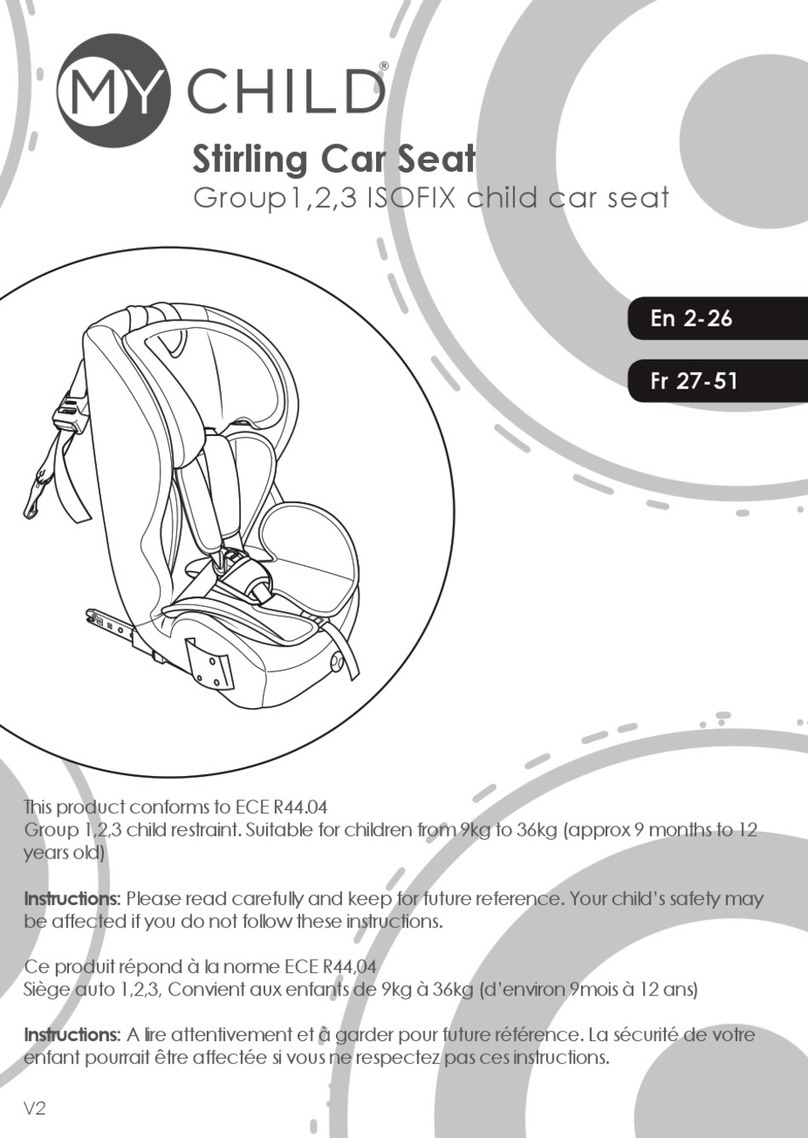
My Child
My Child Stirling User manual

My Child
My Child Easy Twin User manual
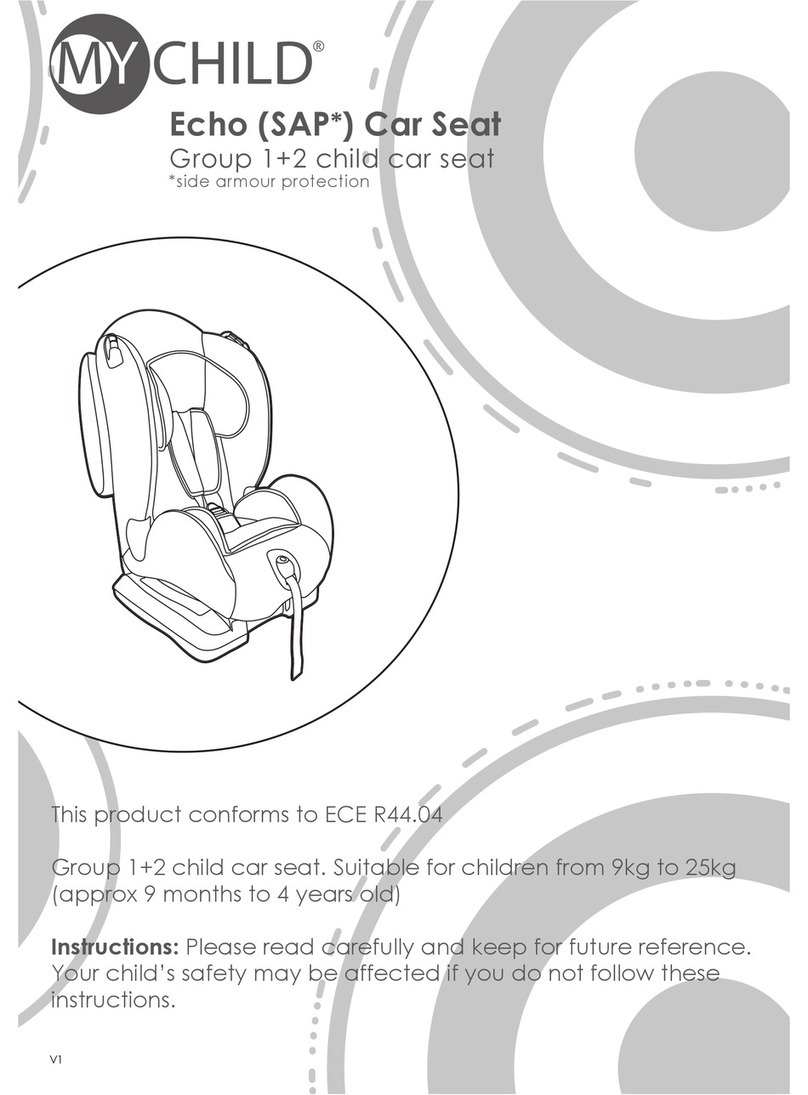
My Child
My Child Echo (SAP) User manual

My Child
My Child Jet Stream User manual
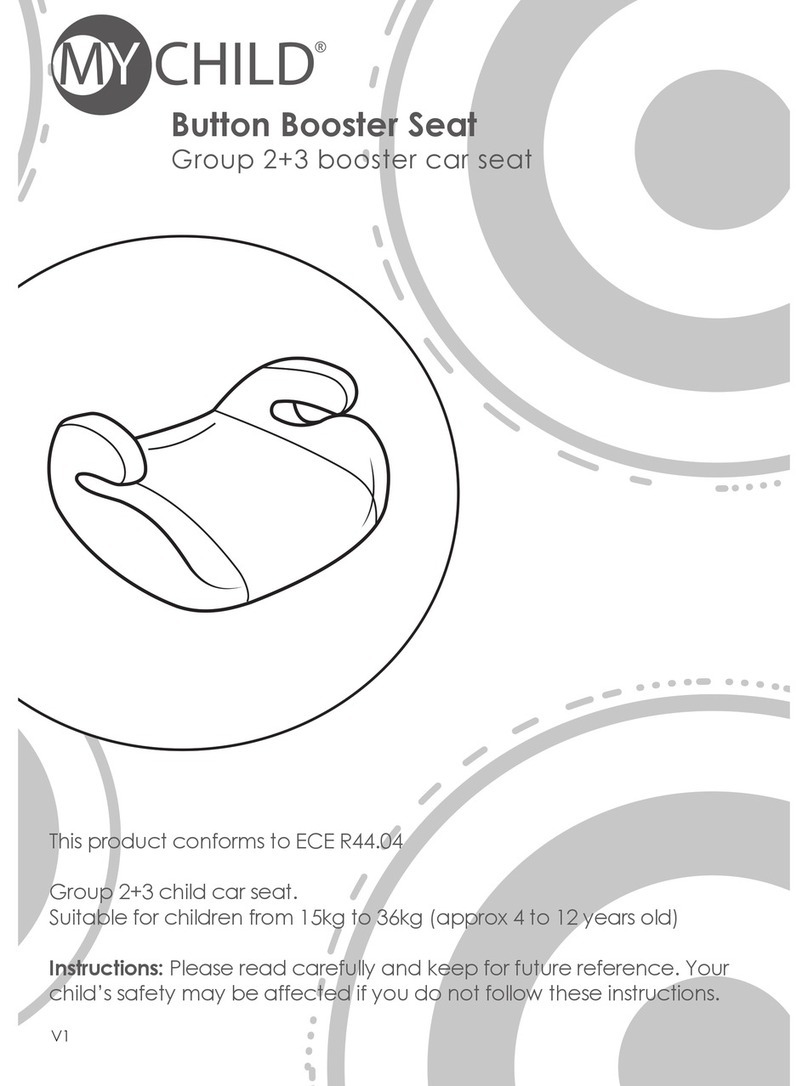
My Child
My Child Button Booster Seat User manual

My Child
My Child Rapido Fix Car Seat User manual
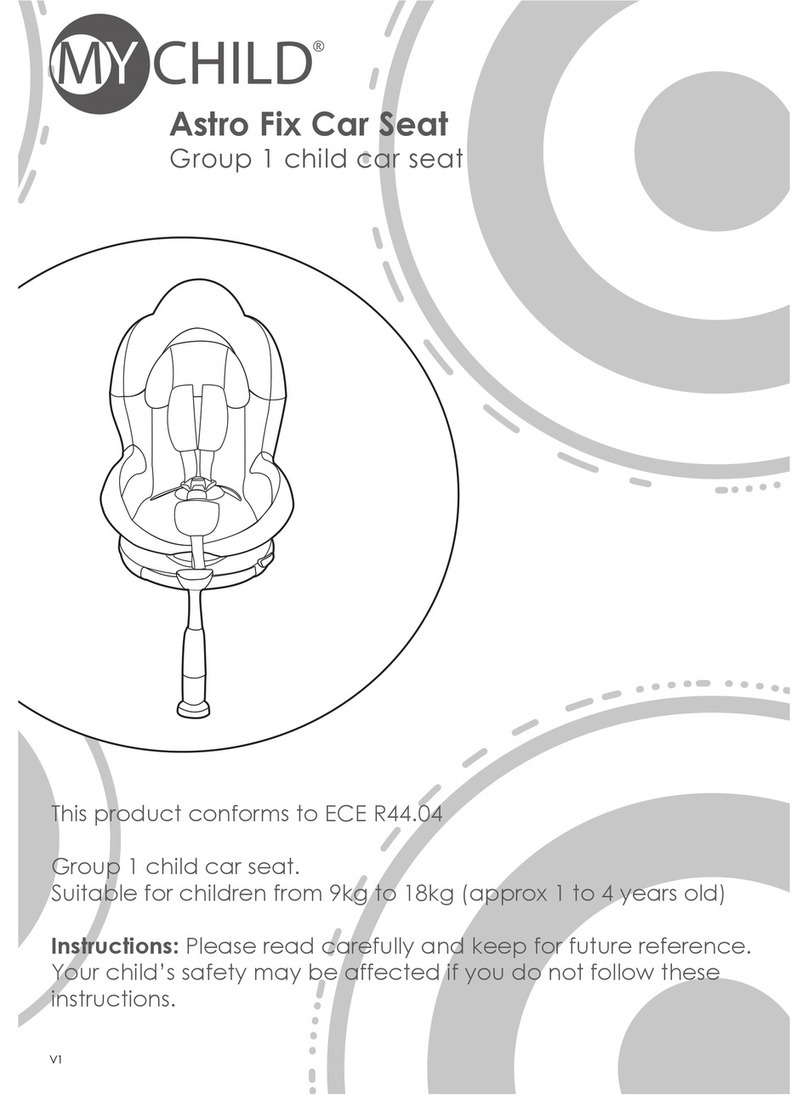
My Child
My Child Astro User manual
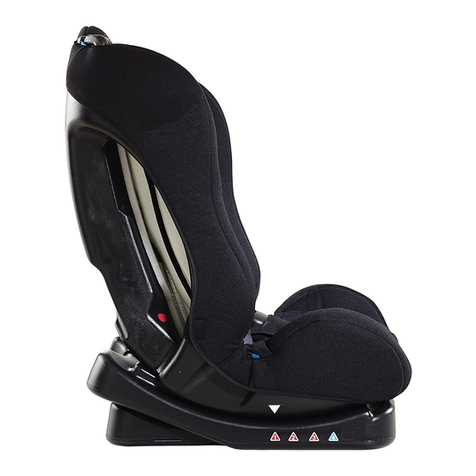
My Child
My Child Chilton User manual
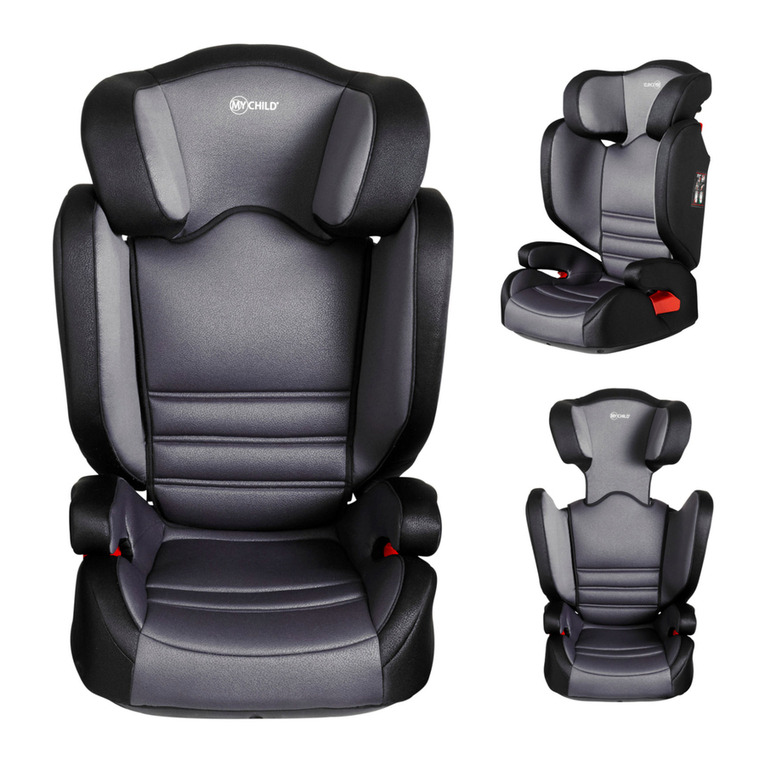
My Child
My Child Expanda User manual


